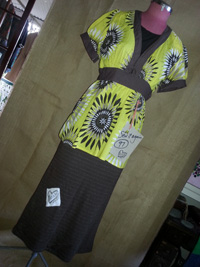 No problem can be solved from the same level of consciousness that created it, is one of my favourite Albert Einstein quotes.
No problem can be solved from the same level of consciousness that created it, is one of my favourite Albert Einstein quotes.
Most thinking people appreciate we are consuming resources at an unsustainable rate, eating into reserves that belong to future generations and generally abusing our natural environment. Many know it, few make changes.
As with the rising interest in home cooking and food growing for improved health and wellbeing, there is a pressing need to rethink our approach to textiles and fashion for ecological health and sustainability. That’s why I’ve embarked on the 365-day Sew it Again campaign throughout 2014 to demonstrate creative ways of reusing existing garments by empowering individuals to reimagine and recreate their own wardrobe collection by resewing at home.
In so doing, I am pleased to be part of Fashion Revolution Day’s Australia & New Zealand committee bringing awareness about the reality of where clothes come from and the resources from which they are made.
April 24 marks one year since the Rana Plaza building collapse in Bangladesh when 1133 people were killed as they worked in a sweat shop creating fast fashion for Western consumers. It was a watershed moment for the fashion industry because it shone light on unethical and unsustainable practices.
This year as a conscious and global response, 24 April 2014 is Fashion Revolution Day which is harnessing the power of fashion to catalyse change and reconnect the broken links in the supply chain. You’re urged to “wear your clothes inside-out to help start the beginning of an industry-wide transformation towards a more sustainable future. Show us your inside out clothes on Instagram by tagging it @Fash_Rev and #InsideOut “
In an April Vogue magazine article, How The World Has Changed Since Rana Plaza, Dolly Jones writes: “On the global stage, fair-trade pioneer Carry Somers, fashion activist Lucy Siegle and Livia Firth have declared April 24th an annual Fashion Revolution Day – for which people all over the world will be encouraged to wear their clothes inside-out. “We want people talking about the provenance of clothes,” says Somers, “raising awareness of the fact that we aren’t just purchasing a garment, but a whole chain of value and relationships. FRD will become a platform for best practice – for brands to show off what they are doing to improve things.”
“As consumers, we want people to re-engage with fashion, slow things down a bit, love the clothes we buy more,” adds Firth. “Care about how they are made and by whom … If we imagine we are voting every time we buy something, and we use our purchase power, then things will change.”
When the recent IPCC confirmed that climate change is real, I wrote about the link between our clothing habits and climate change (Sew 91): “We often think the small actions we take as individuals cannot have an impact on the planet, but it is the collective impact of many small actions that can make a difference.”
Vogue quotes Cate Blanchett: “Garment manufacture demands the same attention as climate change. If you offer options then it’s not sacrifice, it’s choice,” she says. “As well as the fundamental improvement to our spiritual health, buying with conscience is about the option to buy something for £1 that has the potential to blind 15 children as a result of an inhumane production line – or something else for £1.50 that will have a positive effect. Like climate change – we need to change the way we consume fashion. And if more individuals do then we make a change collectively.”
So in the lead up to Fashion Revolution Day, have a look at your labels – be curious, find out, do something positive.
While others work on industry issues along the supply chain, I’m doing my little bit locally to empower individuals to make their own changes by upcycling cast-off clothing using a few simple sewing skills to give existing clothing a second life.
Today’s upcycle is easy. For Sew 97, this cotton op-shop top was fine, except the puff sleeves were too tight. I solved that problem by cutting open the seam under the arm and using zigzag stitch to stop it fraying – a five minute upcycle. I have teamed this with a straight skirt I made a while ago that had developed a small hole – which I covered with my Textile Beat upcycled logo on the outside, as a badge of honour.
